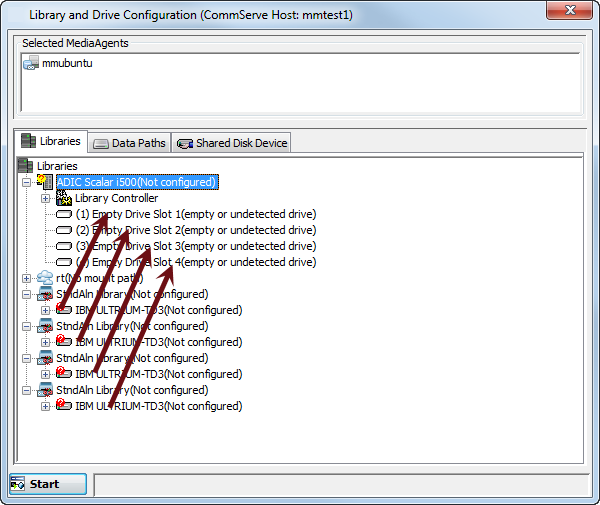Configuring a Library with the Same Drive Type
Use this procedure to configure a direct-attached library that has the same drive type.
-
On the ribbon in the CommCell Console, click the Storage tab, and then click Expert Storage Configuration.
-
Under Available MediaAgents, select the MediaAgents that are attached to the library and on which the library needs to be configured and then click Add >>.
Click OK.
Note
-
To configure any shared library, make sure that you select all of the MediaAgents that share the library.
-
If a device has already been configured for the MediaAgent, the device appears in the Expert Storage Configuration dialog box.
-
For cluster, select the cluster server as the MediaAgent.
-
-
Click OK to continue.
-
Right-click Libraries, and then click Detect/Configure Devices.
The Detect Library dialog box appears.
-
Select the appropriate options.
-
SCSI Devices - If your library is attached to the SCSI or Fibre Channel (FC) Adapter.
-
Detect on Selected MediaAgents in Parallel - If you are performing the detection for multiple MediaAgents.
-
Automatically create DDS Drivepools - If your library is attached to multiple MediaAgents in a SAN environment.
-
NDMP Devices - If your library is attached to a NAS filer.
-
Exhaustive Detection - Only for libraries without Drive IDs support.
Click OK.
-
-
Optionally, from the Processing dialog box you can perform the following operations:
-
Click Abort to stop the exhaustive detection operation and then unmount any mounted media from the drives.
-
Click View Log to display the Log dialog box that reports the status of each task that is performed during the exhaustive detection operation.
-
-
When the detection process is completed, the log file appears. Note the log file contents, and then click Close.
-
A message appears that tells you to right-click the device that you want to configure.
Click OK.
The Expert Storage Configuration dialog box displays a master drive pool (with a drive pool and the associated drives) for the library.
- If the library supports SCSI 3 drive identification, the system detects the devices and displays them with detection status detected.
-
Right-click the library, and then click Properties.
The Library Properties dialog box appears.
-
If you do not want to create a storage policy that is associated with this library, make sure that the Automatically create storage policy for new data paths check box is cleared.
-
In the Alias box, enter a descriptive name for the library.
This name appears for the library in the CommCell Browser. We recommend that you give each library a descriptive name to make system administration easier.
-
Click OK.
-
If the library does not support SCSI 3 drive identification, the system detects the library with Empty Drive Slots and the drives as StndAln Library. Do either of the following:
-
Right-click the library, point to Advanced Options, and then click Exhaustive Detection.
-
Physically verify the drives and the appropriate drive slot numbers, and then drag and drop the standalone drives onto the appropriate drives.

-
-
Configure the library.
-
From the Expert Storage Configuration dialog box, right-click the library that you want to configure, and then click Configure.
-
In the Configuration dialog box that appears, select Library and all drives.
-
A message appears that asks you if your library has a barcode reader.
-
Click Yes, if the library has a barcode reader (sighted library).
-
Click No, if the library does not have a barcode reader (blind library).
-
-
The Discover Media Options dialog box appears.
-
If the library does not have a barcode reader, select the correct media type that is available in the library.
-
If the library has a barcode reader, do either of the following:
-
To discover the media in the library automatically, select the default media type, and then click Yes.
-
To discover the media manually, click No.
-
-
Make sure that media is discovered before you use the library for a data protection operations.
The status of the library changes to Configured in the Expert Storage Configuration dialog box.
The Libraries tab provides the physical view of the devices (library and drives).
The Data Paths tab provides a logical view of the data path used to access the devices (library, master drive pool, drive pool, and drive).
-
Related Topics
Provides information about Device Detection, Exhaustive Device Detection, and SCSI 3 drive identification.
Describes the various library operations that can be performed from the CommCell Console.
Describes the various media-related operations that can be performed in a tape library.